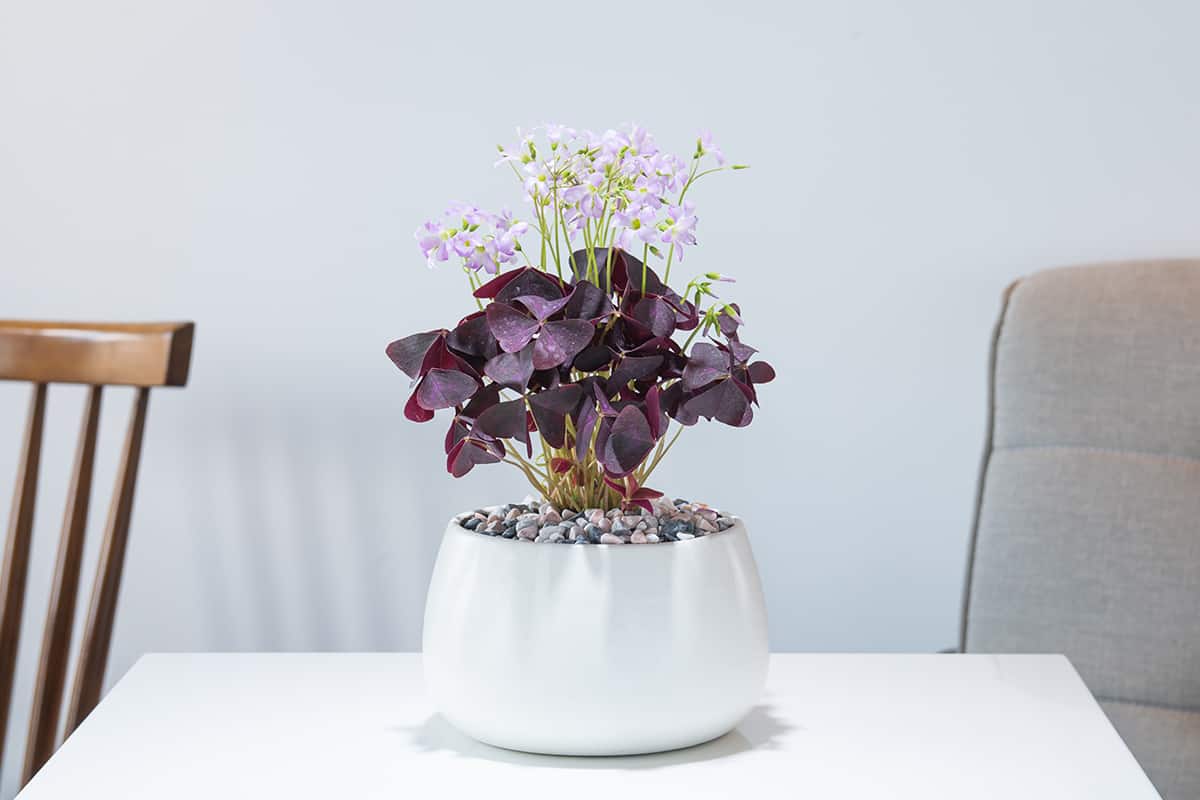When you bring purple houseplants into your home, it’s like adding a special touch that makes everything look nicer. These plants, with their cool purple leaves, can make any room feel more relaxing and interesting. Purple plants are great for anyone wanting to add some color to their space without needing a lot of extra work.
In this article, we’ll go over a variety of purple houseplants and we’ll give you some tips on how to take care of them easily.
Table of Contents
- Saintpaulia Ionantha (African Violet)
- Gynura aurantiaca (Purple Velvet Plant)
- Tradescantia Pallida (Purple Heart)
- Hemigraphis Alternata (Purple Waffle Plant)
- Oxalis Triangularis (Purple Shamrock)
- Strobilanthes Dyerianus (Persian Shield)
- Calathea Veitchiana (Medallion Calathea)
- Solenostemon Scutellarioides (Coleus)
- Tradescantia Zebrina (Wandering Jew)
- Neoregelia (Bromeliad)
- Begonia Rex (Rex Begonia)
- Alocasia Reginula (Black Velvet Alocasia)
- Peperomia Caperata ‘Burgundy Ripple’ (Ripple Peperomia)
- Aglaonema ‘Red Emerald’ (Red Aglaonema)
- Phalaenopsis Spp. – Specifically Purple-Flowered Orchids
- Calathea Rufibarba ‘Wavestar’ (Velvet Calathea)
- Cordyline Fruticosa ‘Red Sister’ (Cordyline)
- Epiphyllum Oxypetalum (Purple Orchid Cactus)
- Lavandula Angustifolia (Lavender)
- Chlorophytum Comosum ‘Bonnie’ (Purple Spider Plant)
- Sinningia Speciosa (Gloxinia)
- Streptocarpus Spp. (Cape Primrose)
- Plectranthus Scutellarioides ‘Wizard Velvet Red’ (Wizard Velvet Red Coleus)
Saintpaulia Ionantha (African Violet)
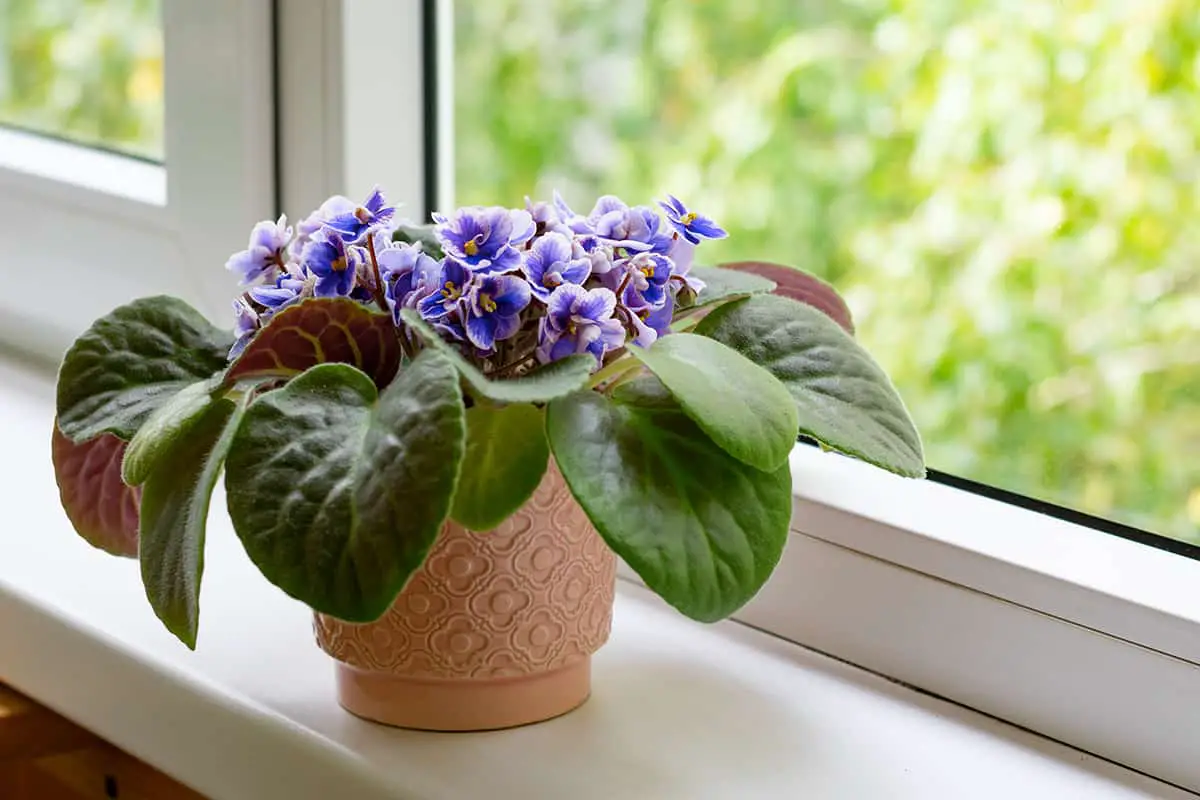
Saintpaulia Ionantha, also known as African Violet, is a favorite among houseplant enthusiasts. You can easily recognize this plant by its velvet-like leaves and vibrant flowers. Typically, its blooms range in color from deep purples to pale lavenders and even white.
African Violets flourish under moderate to bright, but indirect light, and it’s important to shield them from direct rays that could damage their leaves.
Maintaining a consistent moisture level in the soil of your African Violet is crucial, yet it’s equally important to avoid overwatering to prevent the dangers of root rot.
Propagation of African Violets is efficiently achieved through leaf cuttings, a straightforward method that can multiply your collection or create gifts for fellow plant enthusiasts.
With attentive care, African Violets can go through several flowering cycles annually, bringing continuous vibrancy to your space with their long-lasting blooms.
Originating from Eastern Africa, these plants thrive in a climate that’s both warm and humid, a condition that can be recreated indoors with higher room temperatures or the use of a humidity tray.
Gynura aurantiaca (Purple Velvet Plant)
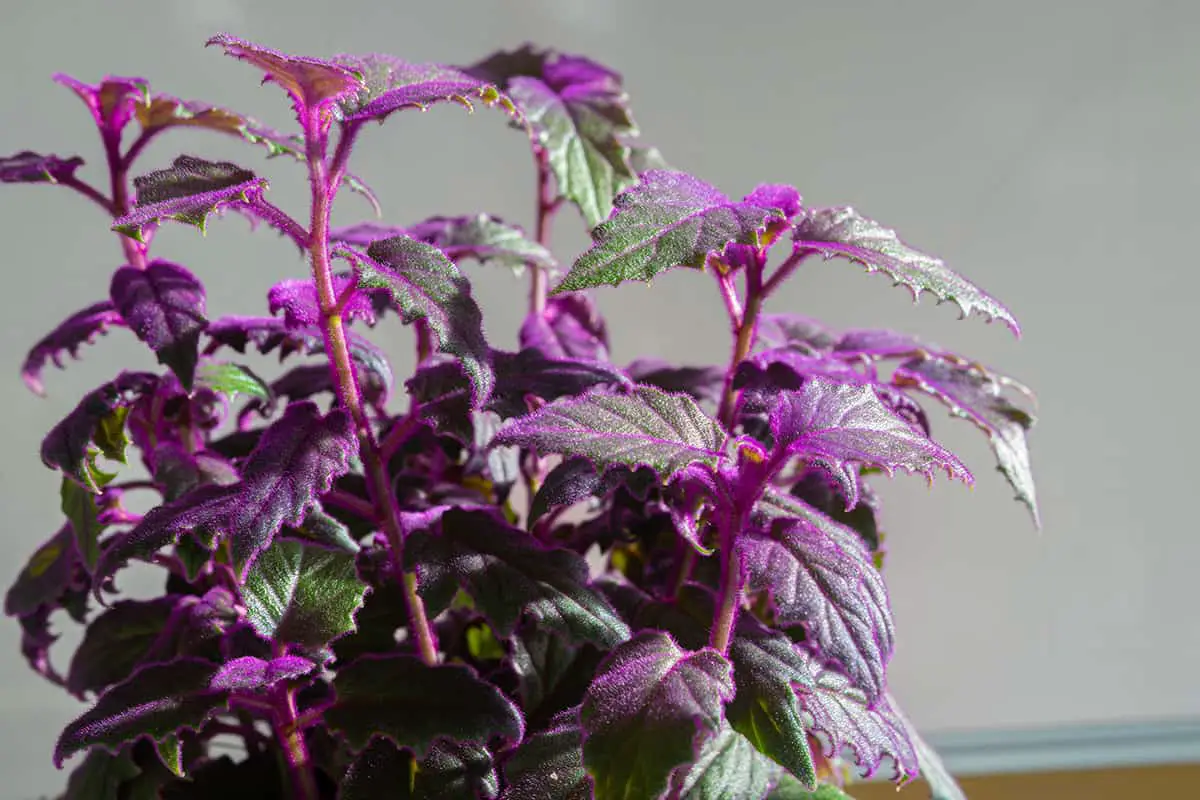
The Purple Velvet Plant, known scientifically as Gynura aurantiaca, is a striking houseplant that brings a splash of color indoors with its rich, purple leaves. You’ll appreciate this plant’s unique texture, given its soft, velvety foliage. It’s a popular choice for those wanting to add vivid hues to their plant collection.
Your Purple Velvet Plant prefers bright but indirect light to maintain its vibrant color without damage from harsh sun rays. Ensure the soil stays moist, certainly avoiding over-watering, which might lead to root rot. This plant thrives in a well-draining medium.
To keep your Purple Velvet Plant bushy and compact, you might consider pinching back the stems. This method curbs leggy growth and promotes denser foliage, enhancing the plant’s overall appearance. The plant does emit an unpleasant odor when it blooms, so many choose to remove the flowers to keep a focus on the foliage.
When nurturing your Purple Velvet Plant, keep an eye out for signs of distress, like wilted leaves, which may point to excess fertilizer. Waste no time in leaching the potting media to alleviate potential fertilizer burn.
Tradescantia Pallida (Purple Heart)
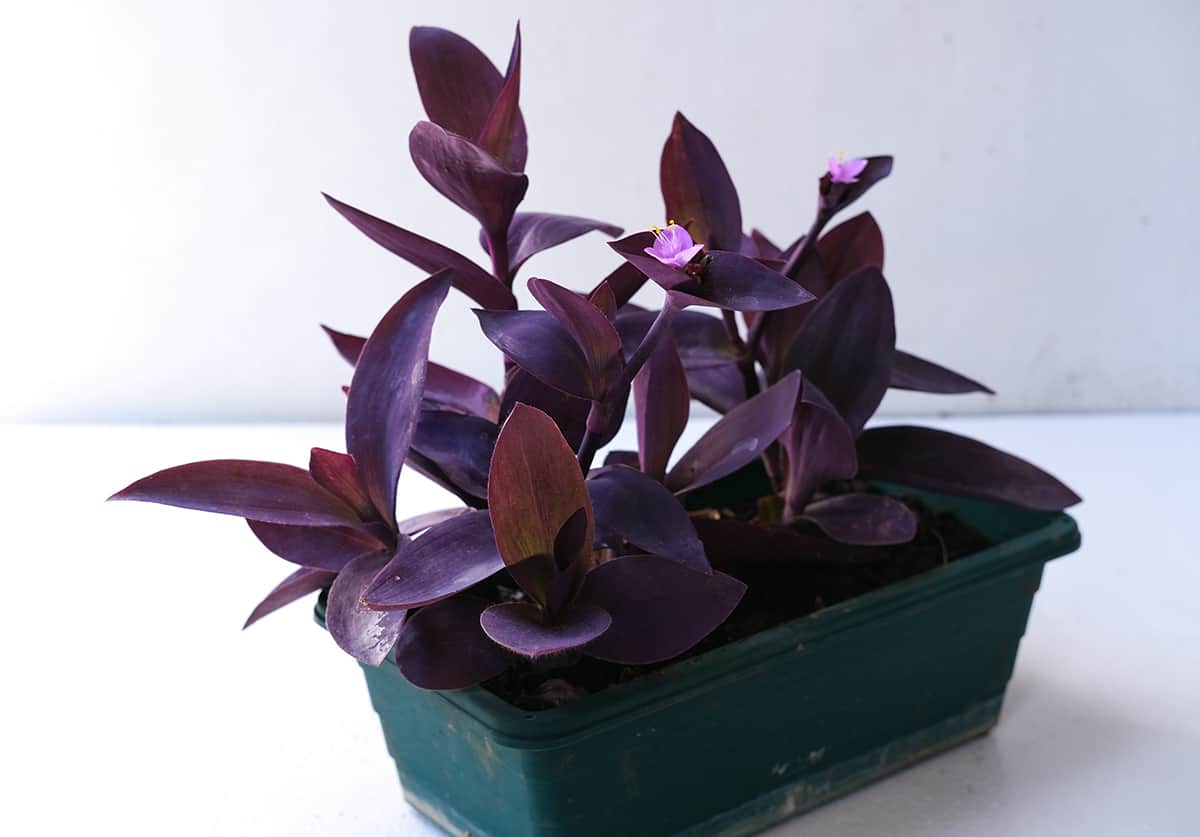
Tradescantia Pallida, known as Purple Heart, is a striking houseplant with vivid foliage. Its purple leaves grab attention, making it a popular choice for adding a splash of color indoors. In summer, Purple Heart blooms with small pink flowers that complement its violet-purple leaves.
You’ll find the care for this plant quite straightforward. It thrives in locations with full sunlight to partial shade. If you plant your Purple Heart outside, choose well-draining soil to promote healthy growth. During the cooler months, the plant might need protection to survive, especially in colder climates.
Purple Heart often serves as a ground cover in suitable climates, thanks to its trailing growth habit. When used as a houseplant, it prefers temperatures above 50 degrees Fahrenheit. Keep the soil moderately moist, and fertilize during the growing season for the best results.
Cuttings can be easily rooted in water or soil to propagate the Purple Heart. This is an excellent way to expand your collection or share with friends.
Hemigraphis Alternata (Purple Waffle Plant)

The Purple Waffle Plant is a tropical perennial often admired for its textured leaves. You can recognize it by its unique foliage that appears puckered with a color that pops in shades of purple. Its scientific name is Hemigraphis alternata.
Your indoor garden benefits from this plant as it works to purify the air. Research identifies the Purple Waffle Plant as efficient in removing indoor pollutants. It’s among the most effective at making your indoor space healthier.
When caring for Hemigraphis alternata, ensure it receives indirect sunlight or partial shade. It thrives away from direct sunlight, which can harm its leaves. To keep the metallic sheen on its foliage, provide regular watering but avoid overwatering.
Despite its delicate appearance, the Purple Waffle Plant is robust against common houseplant diseases. Problems like scale and whiteflies are less troubling if you maintain proper care. Remember, it’s typically grown as an annual or in a container, especially if you live in cooler climates.
Oxalis Triangularis (Purple Shamrock)
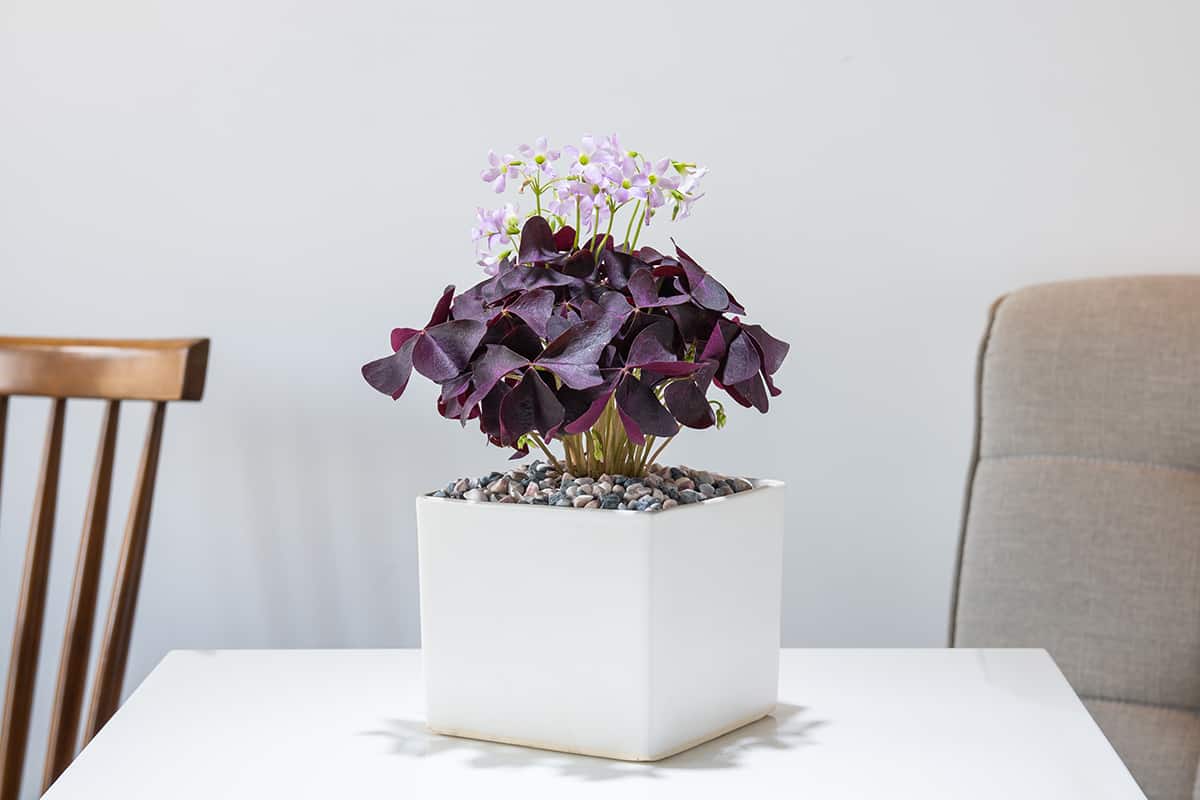
The Oxalis Triangularis, commonly known as the Purple Shamrock, stands out for its vivid, triangular leaves. You’ll recognize these plants by their deep purple color. Native to Brazil, it has recently gained popularity for its unique appearance and adaptability as a houseplant.
For optimal growth, place your Purple Shamrock in an area with bright, indirect sunlight. Too much direct light can harm the leaves, while too little can dull their vibrant color. Consistent, moderate watering is key. Let the soil’s surface dry between sessions to prevent root rot.
This plant exhibits an interesting behavior: its leaves fold up at night or when touched. It’s a defense mechanism and adds to the charm of the plant. In spring and summer, expect delicate flowers to bloom above the foliage. They may be white or pink, adding a subtle contrast to the purple leaves.
When caring for your Oxalis Triangularis, remember to provide a resting period. If the plant goes dormant, reduce watering until new growth signals the end of its rest phase. This cycle allows the plant to thrive year after year.
Strobilanthes Dyerianus (Persian Shield)
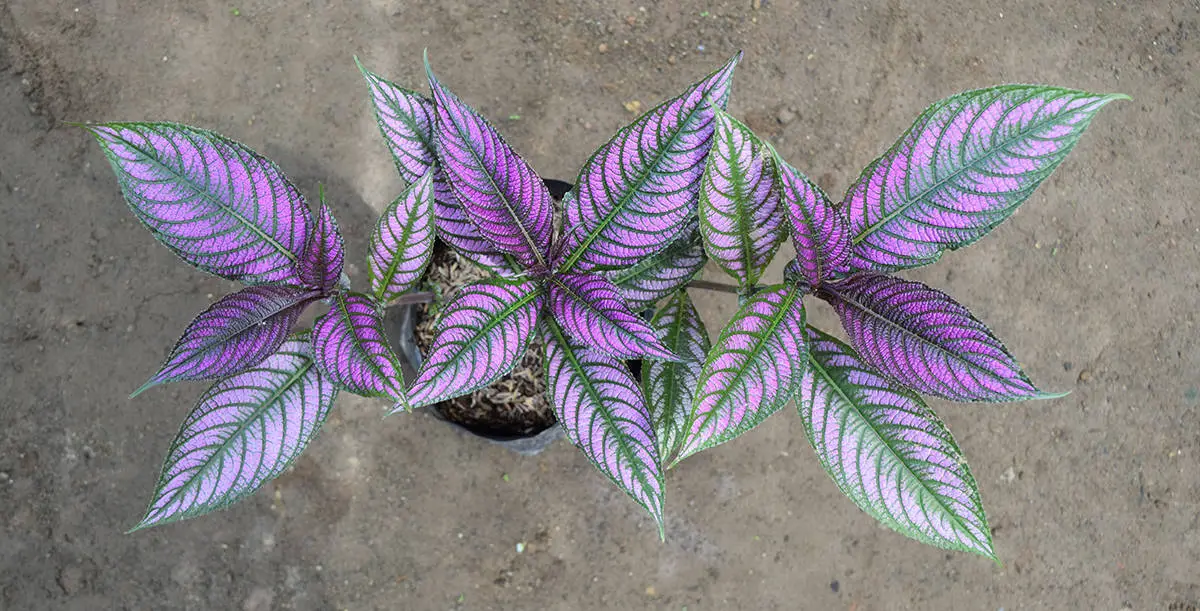
Strobilanthes dyerianus, or Persian Shield, is a tropical plant known for its vibrant leaves. It boasts a unique coloration, primarily iridescent purple with silver patterns. In your garden, this plant adds a touch of the tropics with its shimmering foliage.
This plant thrives in warm environments. You can grow it outdoors in USDA zones 9 to 11. For those living in cooler climates, it makes a superb indoor plant. It prefers bright, indirect light but can tolerate some shade. Keep in mind that too much direct sunlight can fade its distinctive leaf color.
The Persian Shield typically grows a few feet tall. Its height makes it stand out in both garden beds and indoor settings. To keep the plant bushy and full, regular pinching back of the stems is advisable. This encourages branching and maintains a compact form.
Your Persian Shield will need regular watering. The goal is to keep the soil moist but not waterlogged. Overwatering or poor drainage can lead to issues like root rot. During the winter, reduce watering as the plant’s growth slows.
Calathea Veitchiana (Medallion Calathea)
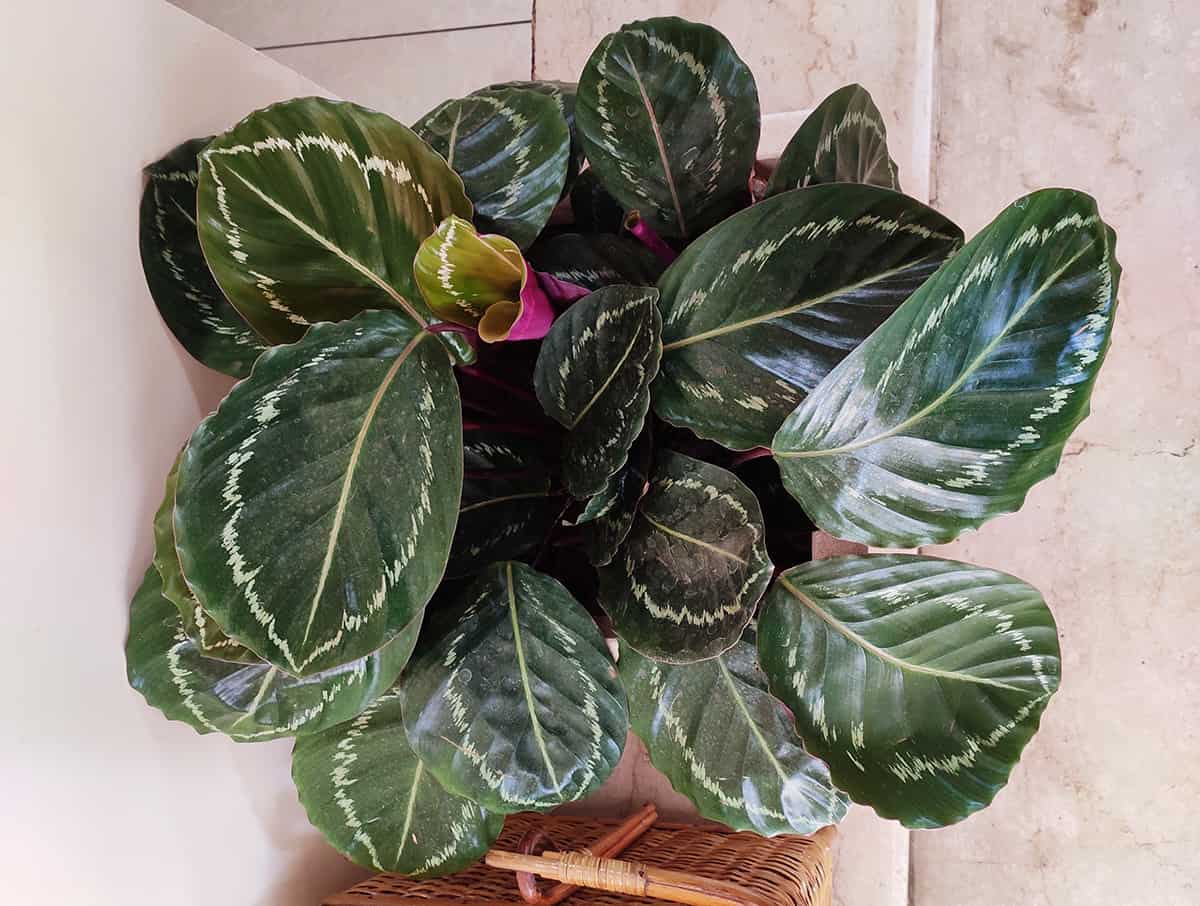
Calathea Veitchiana, widely known as the Medallion Calathea, adds elegance to your home with its distinct foliage. In your indoor plant collection, it stands out with dark green leaves that feature a pattern of deep purple and a touch of silver. The leaves’ undersides are a striking purple, enhancing their overall beauty.
You’ll find that caring for Medallion Calathea is manageable. It thrives in moderate to low light and requires consistent moisture without being waterlogged. High humidity will keep its leaves vibrant and avoid the common issue of brown edges.
Medallion Calathea is a conversation starter due to its patterned leaves. You can expect it to grow to a moderate size, suitable for a table or large desk. It’s useful to note that the plant is not toxic, making it safe around your pets and children.
For optimal growth, remember to provide it with well-draining soil and keep it away from direct sunlight. The Medallion Calathea occasionally raises and lowers its leaves, a sign of its well-being and a display of its dynamic nature.
Solenostemon Scutellarioides (Coleus)
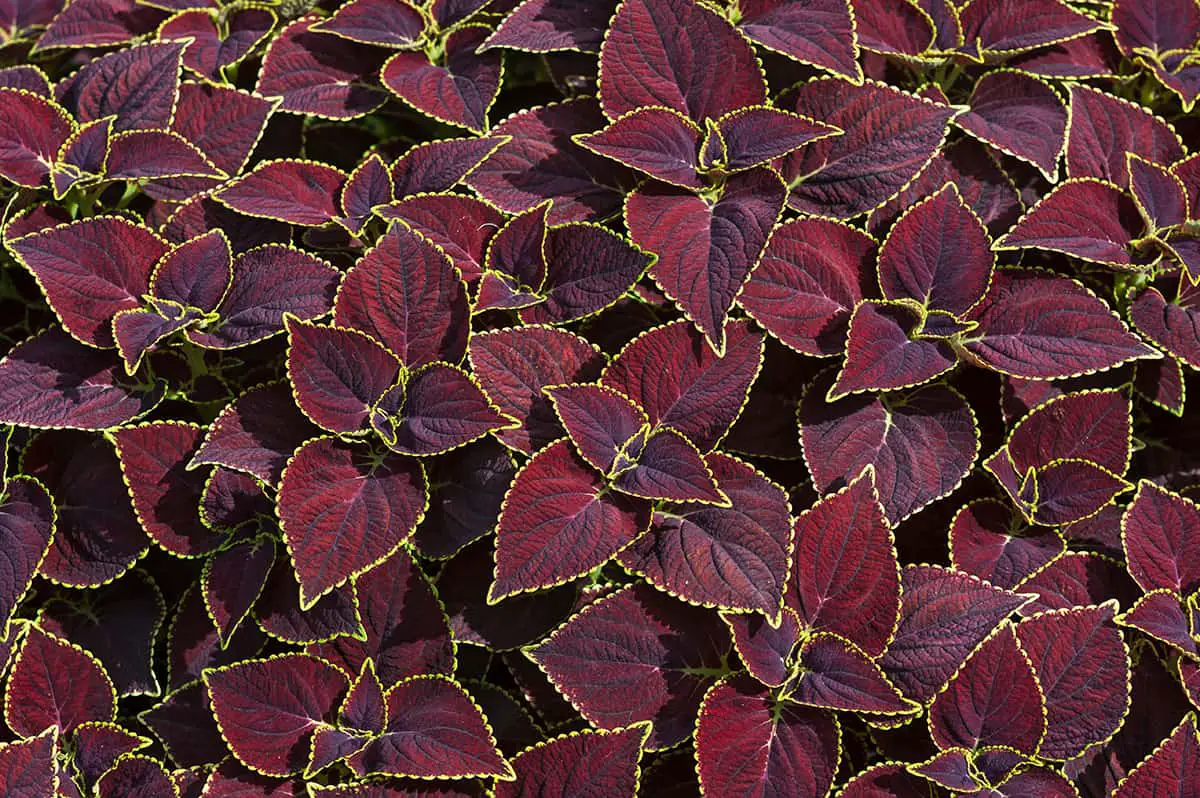
Solenostemon scutellarioides, better known as Coleus, is a vibrant houseplant. You can easily recognize it by its colorful foliage. The leaves come in various shades of purple, along with pink, red, and green.
As a tender perennial, Coleus often grows as an annual outside. If you keep it indoors, ensure it gets plenty of bright light. This will help maintain the richness of its purple hues. Too little light might fade the colors.
When caring for your Coleus, make sure to keep the soil moist. However, avoid overwatering as this can cause issues. Regular pruning will keep it bushy and prevent it from becoming leggy. Pinching off flower spikes directs energy back to the leaves, enhancing the plant’s beauty.
You have flexibility with this plant. It thrives in containers, making it ideal for spaces with limited room. If you want to add a touch of purple to your home, consider incorporating Solenostemon scutellarioides. It delivers color and liveliness to your living space.
Tradescantia Zebrina (Wandering Jew)
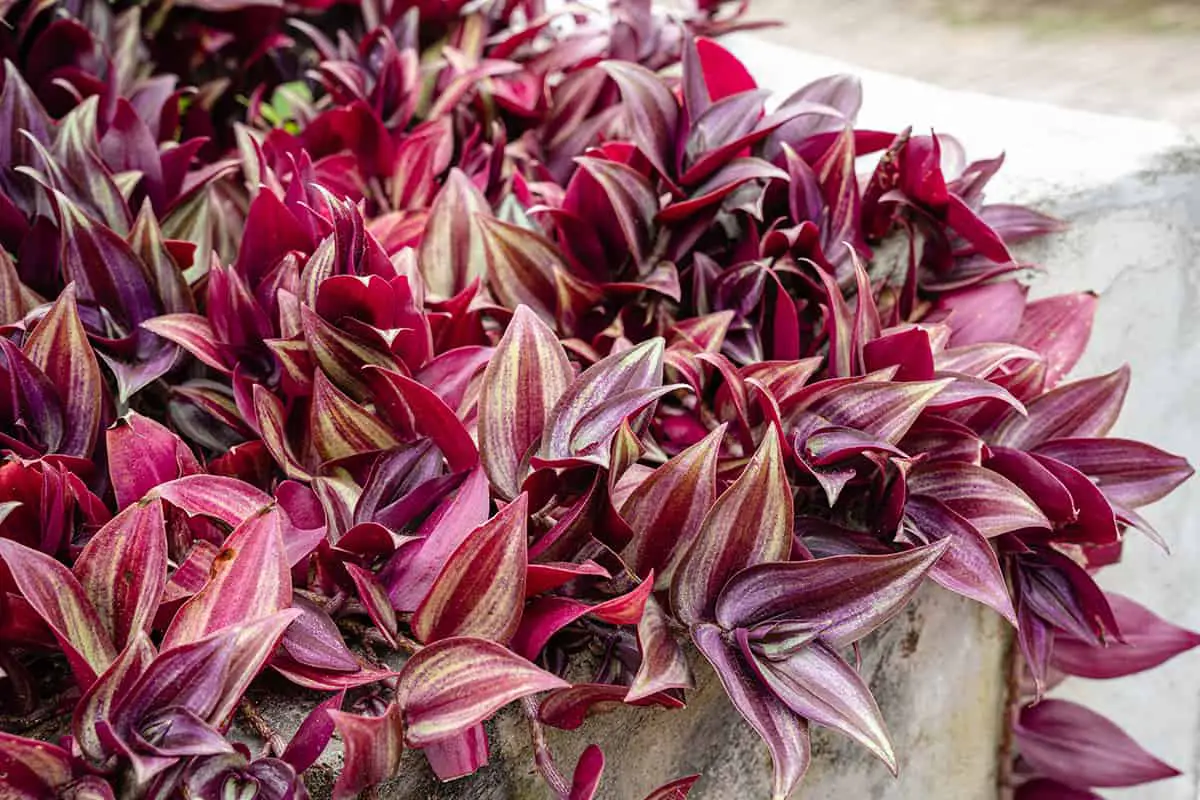
Tradescantia zebrina, known as the Wandering Jew or inch plant, is a colorful choice for your purple houseplant collection. This plant features striking striped leaves. Green, white, and purple hues decorate its foliage, with the purple usually on the undersides. It adds a vibrant touch to indoor spaces.
Your Tradescantia zebrina can grow well under various lighting conditions. However, it thrives best with bright, indirect light to maintain its colorful leaves. Direct sunlight might fade the stripes, so it’s important to find a good spot for it in your home.
As for watering, you should keep the soil moist but not waterlogged. Overwatering leads to root issues, while too little water can cause leaf drop. Finding a balance is key for your plant’s health. Regular misting helps mimic its native tropical environment.
Caring for Tradescantia zebrina requires occasional pruning. This promotes bushier growth and prevents it from becoming leggy. Propagation is simple, too; you just cut a stem and place it in water or soil.
Neoregelia (Bromeliad)
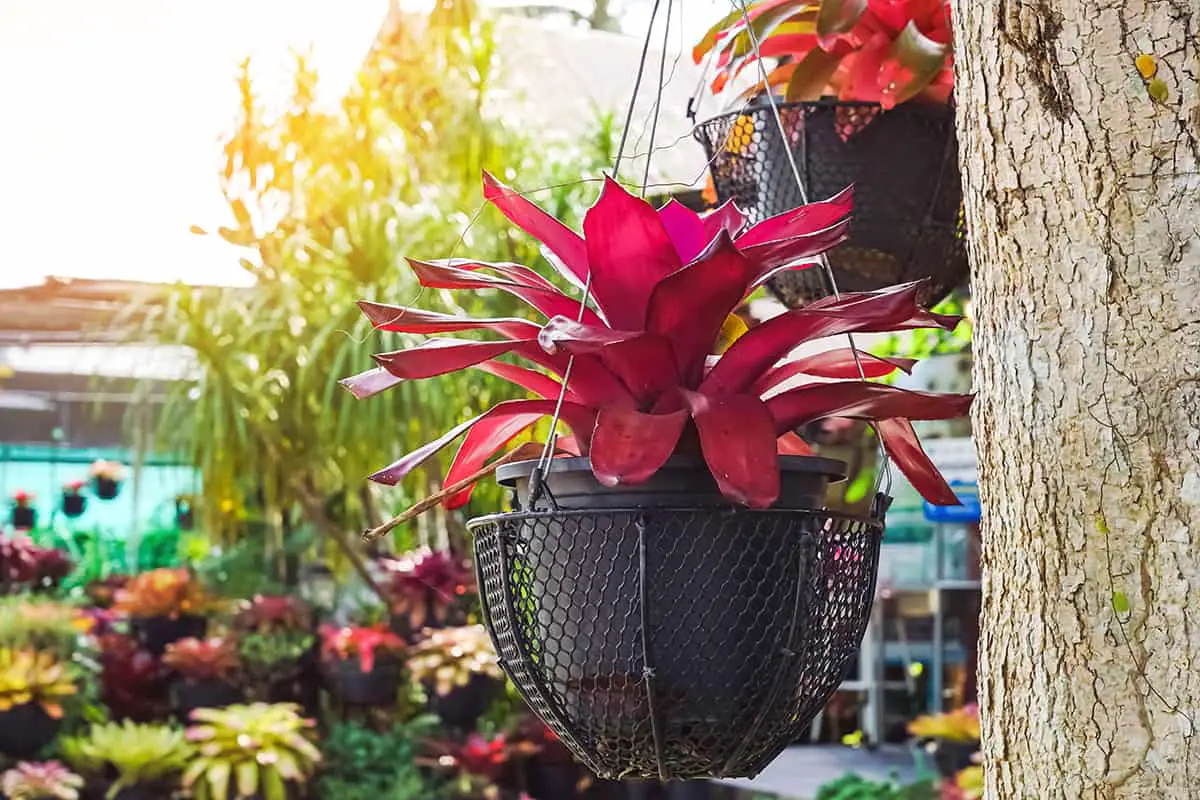
Neoregelia is a type of bromeliad cherished for its striking foliage. Its leaves often boast vibrant colors, adding a pop of purple to your indoor garden. Wide and flat, the leaves can be banded, spotted, or marbled.
These plants form a central “cup” that serves a unique purpose. It gathers water and debris, aiding in nourishment. You need to keep the cup filled as part of routine care. You can easily care for your Neoregelia by providing bright, indirect light. Such conditions will maintain its vivid color.
Neoregelia thrives under the right conditions. With a range of sizes, they’re adaptable to many spaces. They’re also pet-friendly. Non-toxic for cats and dogs, they’re a worry-free choice for pet owners. The addition of these plants to your home will not only brighten spaces, but also offer a safe environment for all your family members.
Special cultivars, like Neoregelia ‘Morado’, can give you even more dramatic coloring.
Begonia Rex (Rex Begonia)
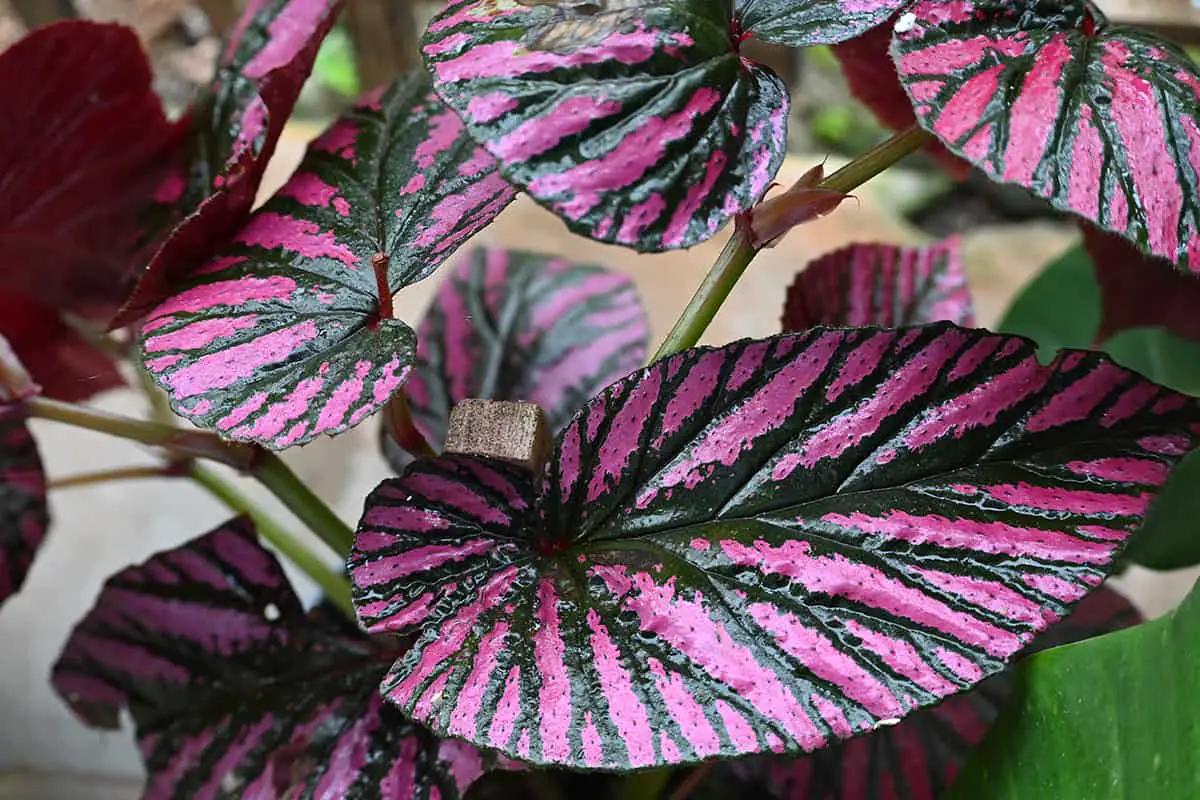
Begonia Rex, also known as Rex Begonia, is a striking houseplant. Its colorful and patterned leaves make it unique. You often find these plants in indoor settings. Their vibrant foliage adds a touch of the tropics to your decor.
Caring for a Rex Begonia is straightforward. They thrive in bright, indirect light and consistent humidity. You should water them when their soil surface dries out. Avoid overwatering to prevent root rot.
These plants are native to regions like eastern Asia. Their ability to adapt to indoor climates makes them popular worldwide. They prefer temperatures between 60-75°F (15-24°C).
Rex Begonias add aesthetic value without occupying too much space. They are suitable for containers, terrariums, or as a desk plant. With their ease of growth, they can be a rewarding choice for novices and experts alike.
Alocasia Reginula (Black Velvet Alocasia)
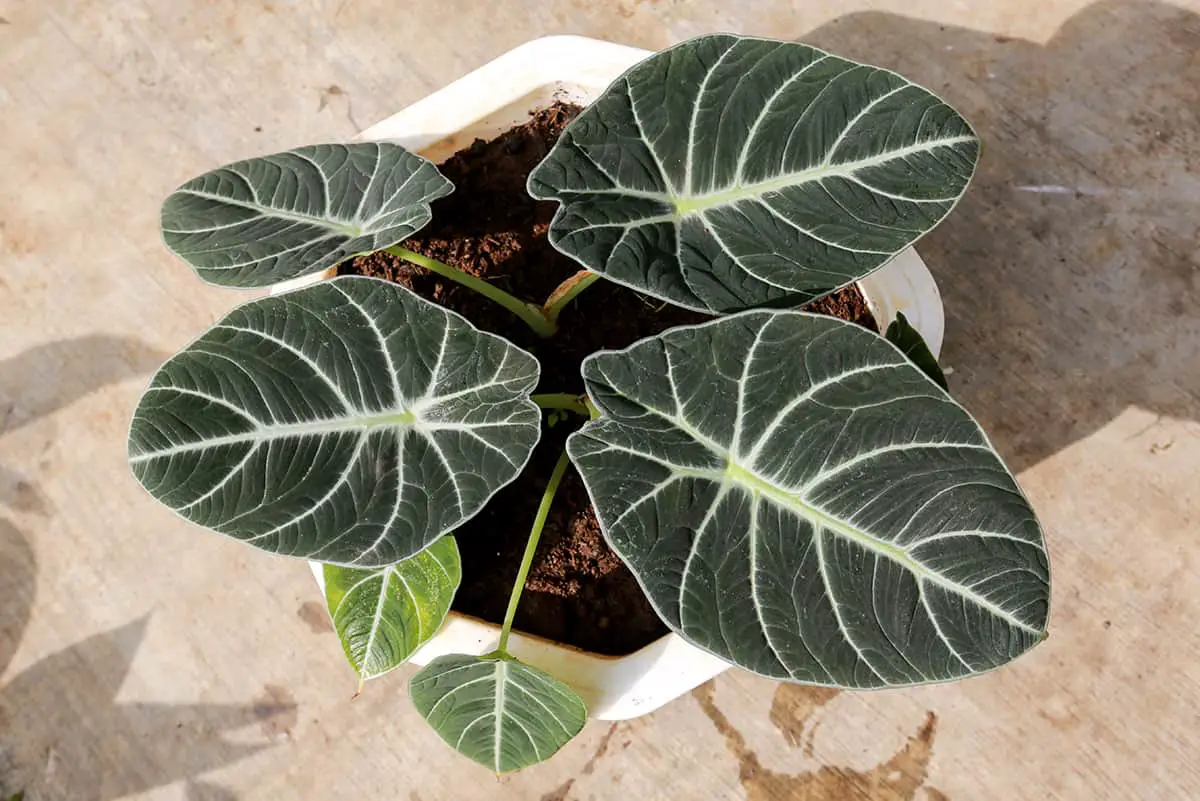
The Alocasia Reginula, known as the Black Velvet Alocasia, offers striking foliage. You’ll notice its lush, velvety, dark leaves first. They are heart-shaped and feature bright veins. The high contrast makes it a standout in your collection of purple houseplants.
This plant stays relatively small, usually below one foot in height. Its compact size makes it a perfect desk or shelf occupant. The Black Velvet Alocasia has a distinctive textured appearance. Its leaves feel soft to the touch, adding a unique sensory experience.
You should provide your Alocasia Reginula with indirect light and adequate moisture. Ensure you allow it to dry out slightly between waterings. It prefers a high-humidity environment to thrive. Overwatering or poor lighting can lead to problems. The plant will reward your care with robust growth and vivid leaf coloration.
Remember, the Black Velvet Alocasia is not just a visually appealing plant. It’s a living sculpture that serves as a focal point in any indoor garden. Its care requires attention, but you’ll find it worthwhile for its stunning appearance. Keep it in a well-draining potting mix to prevent root rot and enjoy its velvety charm.
Peperomia Caperata ‘Burgundy Ripple’ (Ripple Peperomia)
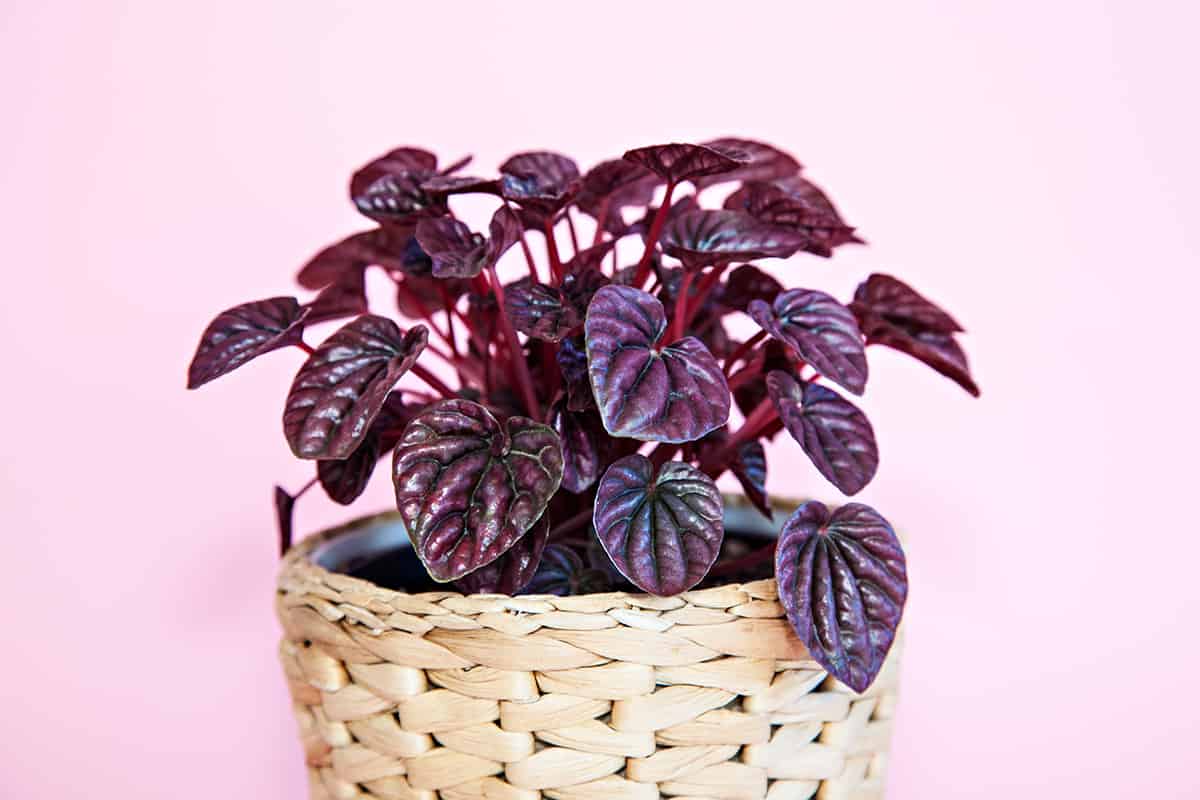
The Peperomia Caperata ‘Burgundy Ripple’ stands out in the world of houseplants with its textured, heart-shaped leaves. The rich, burgundy to dark purple coloring adds depth to your indoor garden palette. You can recognize this plant by its distinctive furrowed foliage. It gives your space a touch of the tropics, yet fits easily into small areas due to its compact size.
Ripple Peperomia prefers bright, indirect light and well-draining soil. Water the plant when the soil feels dry to the touch. This simplicity makes it ideal for beginners or busy plant lovers. Also, since it’s a tropical plant, it enjoys higher humidity, but it will thrive in a typical home environment just as well.
One thing to note about this peperomia is its modest growth. It generally reaches up to 8 inches tall and wide. This makes it a perfect choice for desktops and shelves. The plant flowers occasionally, producing slender, off-white spikes. However, its leaves are the main attraction, with their unique texture and color.
This purple-hued variety is quite versatile and can be enjoyed in various settings. Whether you place it in a hanging basket or use it as a statement piece, it’s sure to grab attention. Remember to keep it out of direct sunlight and overwatering, which can harm the plant.
Aglaonema ‘Red Emerald’ (Red Aglaonema)
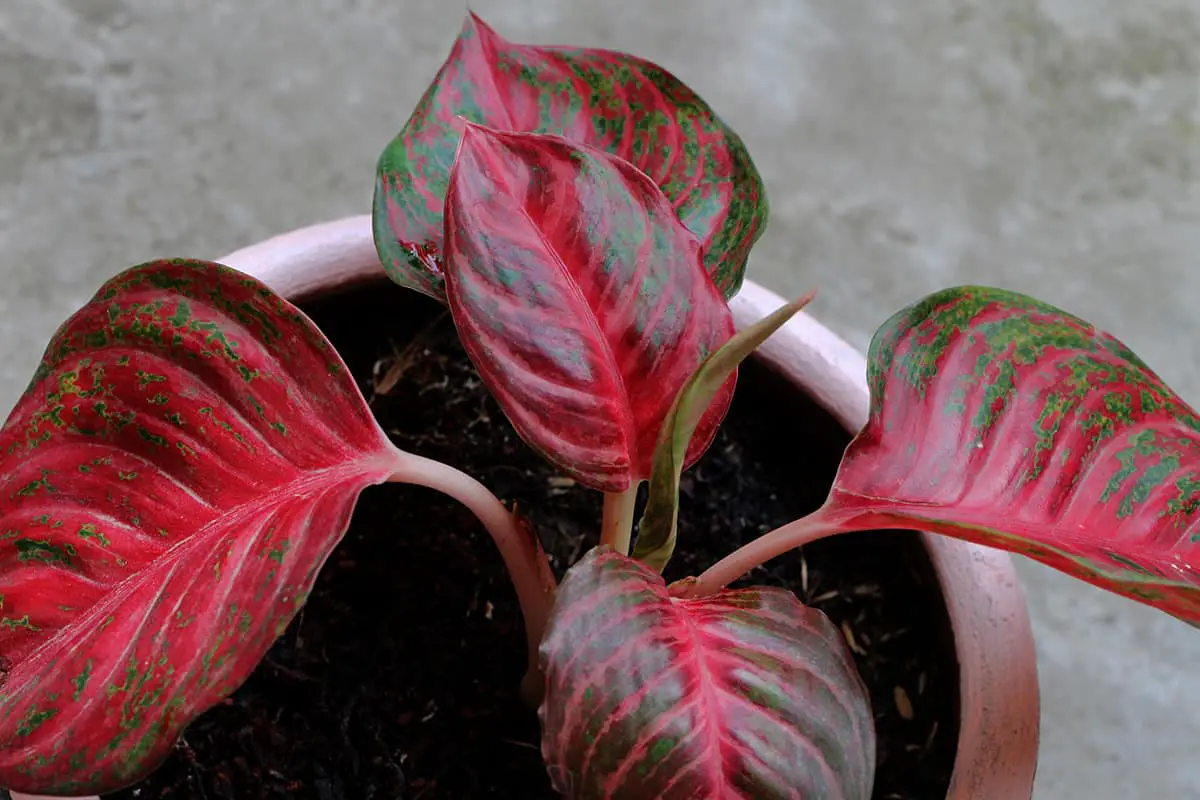
This plant also contributes to your indoor air quality. It helps remove pollutants, making your home’s air cleaner. With its easy care and air-purifying qualities, Red Aglaonema stands out as an excellent plant for beginners.
You can propagate Red Aglaonema by dividing it during repotting. This allows you to share it with friends or expand your own collection. Keep in mind that a well-cared-for Aglaonema can live for many years, providing enduring appeal in your space.
When choosing Red Aglaonema, select a plant with bright, unblemished leaves. This indicates a healthy specimen. With its striking appearance, it will become a focal point in any room. Remember to handle it gently; its stems can be delicate.
Phalaenopsis Spp. – Specifically Purple-Flowered Orchids
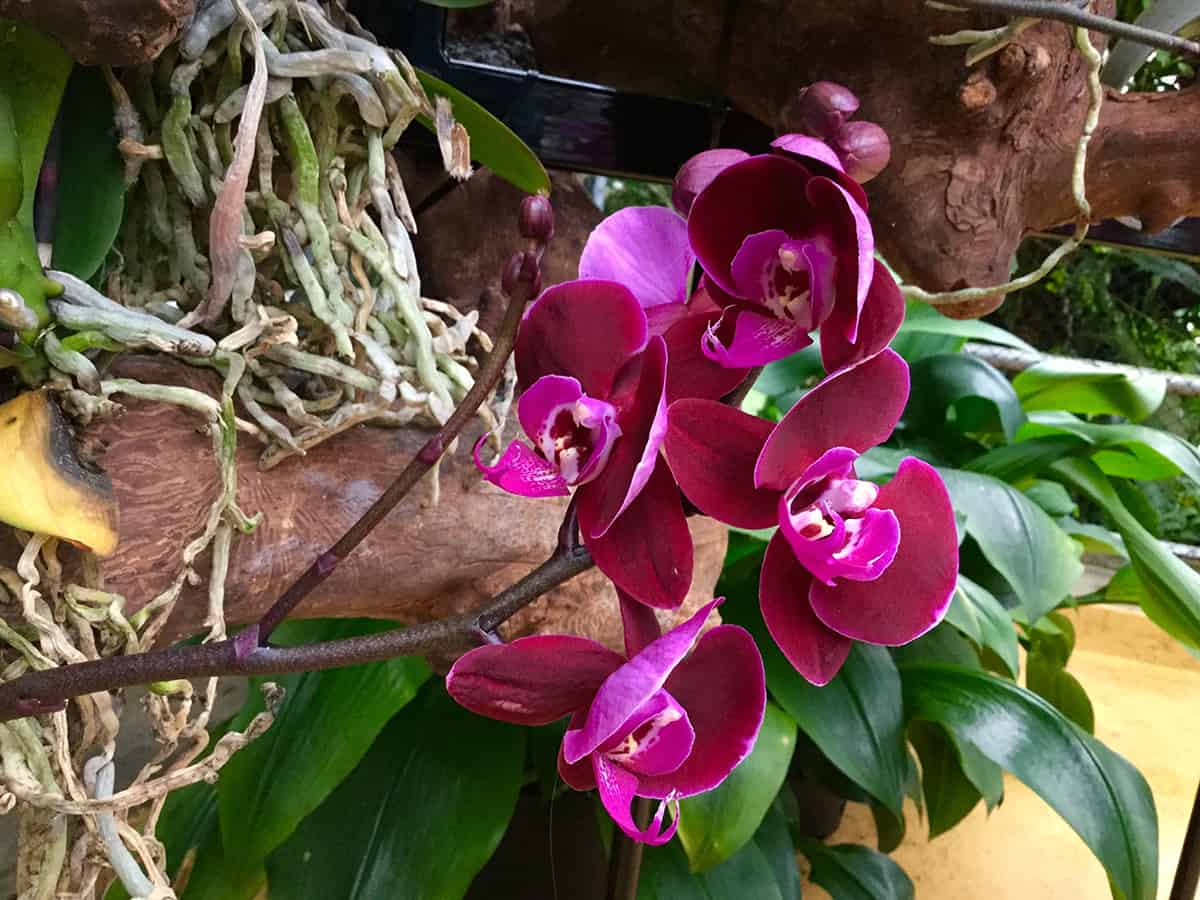
In your search for purple houseplants, you’ll find the Phalaenopsis orchid varieties particularly captivating. These orchids, often referred to as “Moth Orchids,” display stunning purple blooms that can elevate your home’s aesthetic. Phalaenopsis orchids thrive in warm indoor climates and require indirect sunlight to bloom.
For the best growth results, place your Phalaenopsis orchid near an east-facing window. This ensures gentle morning light without the harsher rays of afternoon sun. Overwatering is a common error, so water these plants sparingly. This allows their roots, which should appear vibrant green, to dry slightly between waterings.
These orchids grow well in household temperatures ranging from 70-90° F, with an ideal range between 75-85° F. They enjoy a consistent environment without cold drafts or sudden temperature changes. If potted, ensure you use a well-draining medium and repot every one to three years for optimal health.
Calathea Rufibarba ‘Wavestar’ (Velvet Calathea)
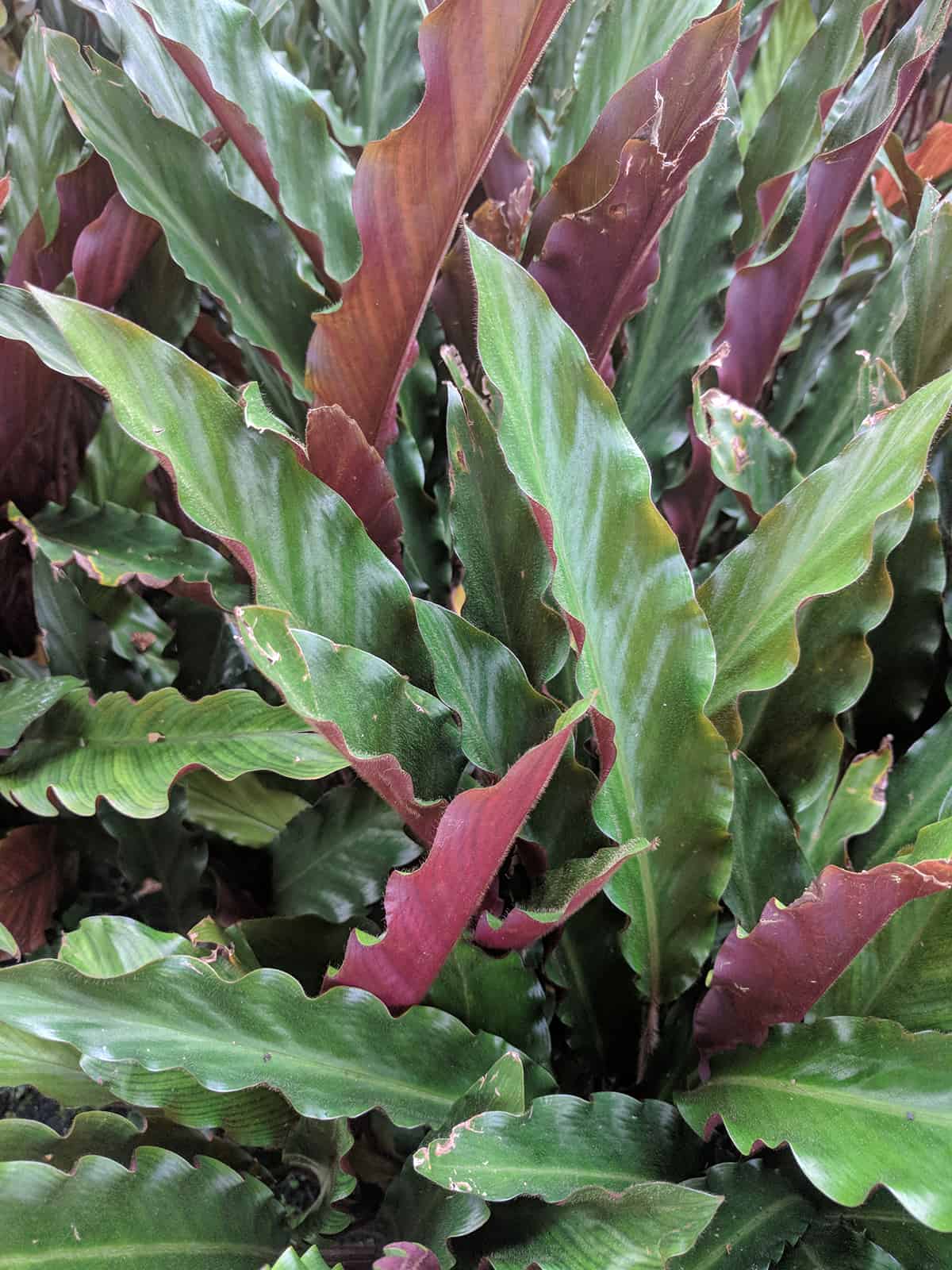
The Calathea Rufibarba ‘Wavestar’ stands out with its velvety, feather-shaped leaves. You will recognize it by the striking olive green color and soft, furry texture. Each leaf gracefully arches, adding elegance to your space.
Your Velvet Calathea enjoys consistent moisture. Ensure the soil remains slightly damp, but avoid waterlogging. Bright, indirect light suits it best. Protect your plant from direct sunlight to prevent leaf burn.
This plant prefers a humid environment. You can increase humidity with a pebble tray or humidifier. It thrives in temperatures ranging from 65°F to 80°F.
Regular feeding during the growing season supports its lush growth. Use a balanced, water-soluble fertilizer every month. In winter, reduce feeding as growth slows down.
Cordyline Fruticosa ‘Red Sister’ (Cordyline)
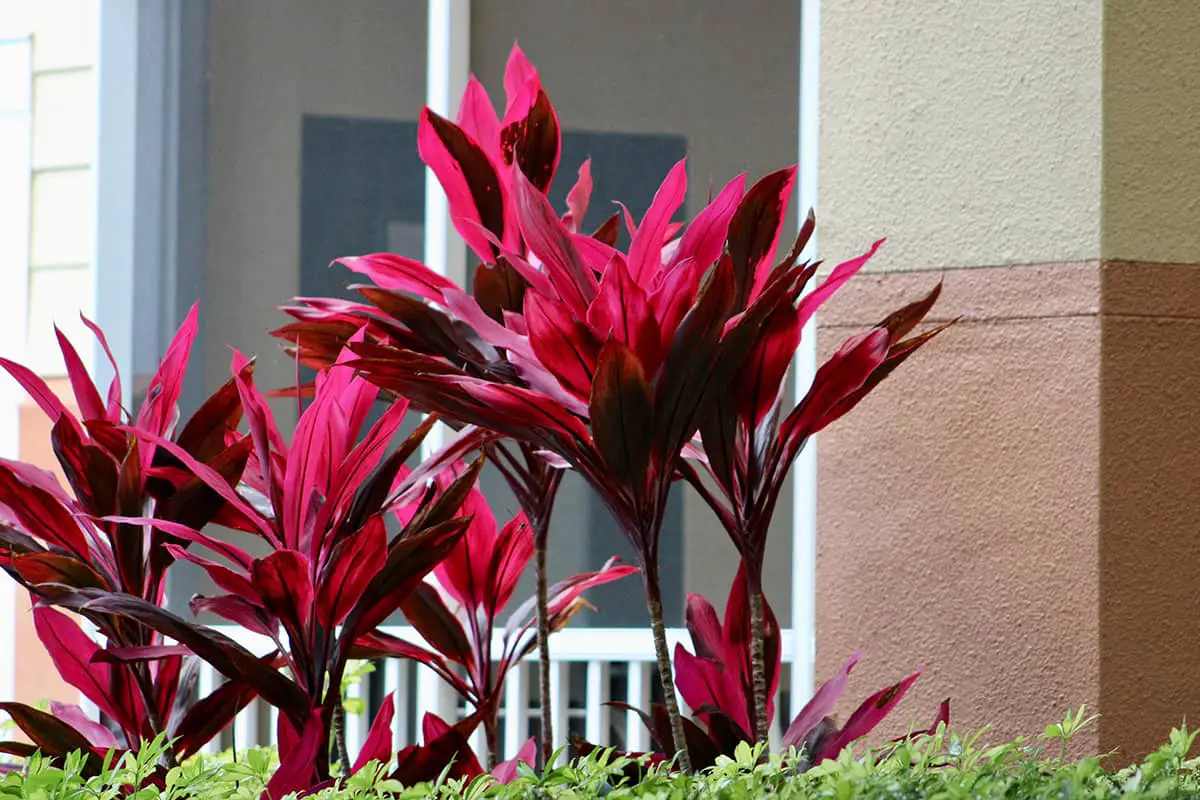
Cordyline Fruticosa ‘Red Sister’ is a striking houseplant. It brings a burst of color with its pink and red foliage, brightening any room. Known for its ease of care, this plant is a popular choice.
Its vibrant leaves demand bright light, so you should protect it from direct sunlight. Your ‘Red Sister’ prefers humidity, so keep the soil moist, but not soggy. This balance supports healthy growth.
Remember, this plant is evergreen, so it thrives indoors year-round. When placed in a suitable environment, your Cordyline can become a stunning focal point. It adds a tropical feel to any interior space.
Toxicity is crucial to consider, so keep it away from pets. Cats, dogs, and horses may experience issues if they ingest this plant.
Epiphyllum Oxypetalum (Purple Orchid Cactus)
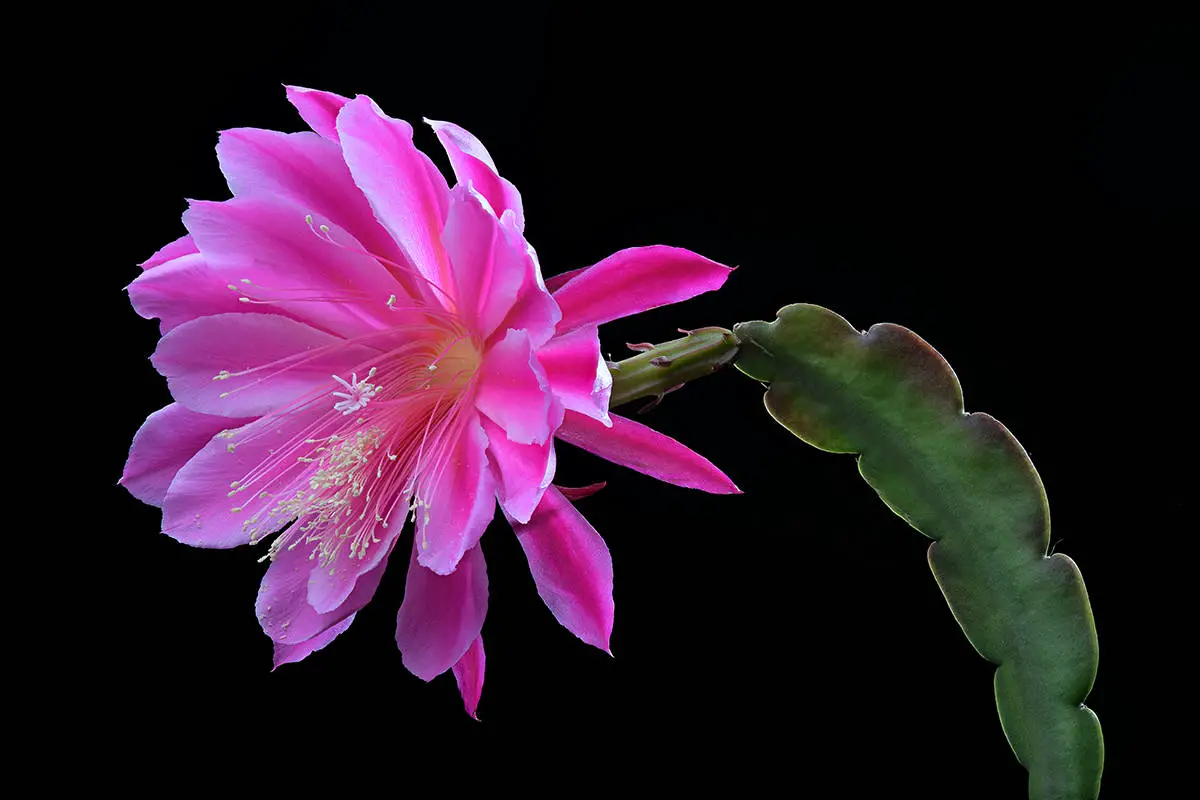
Epiphyllum Oxypetalum, commonly known as the Purple Orchid Cactus, brings a unique flair with its striking blooms to your plant collection. You can enjoy the large, fragrant flowers that open at night and last only until morning. Unfortunately, they’re not actually purple—the “purple” is sometimes used to describe the deep color variability of these blooms.
This tropical cactus thrives in well-draining soil and prefers bright, indirect light. Ensure that you water it sparingly. The plant’s natural habitat as an epiphyte means it’s accustomed to growing on other plants in the wild.
You’ll be surprised at how large this cactus can get, reaching up to 10 feet tall when given the proper support. Keep it in a stable container to prevent any toppling due to its top-heavy nature. Prune the long stems if necessary to maintain stability.
During winter months, remember to reduce watering as the Orchid Cactus enters a resting phase. This practice helps to encourage blooming in the following season. If you live in a cooler climate, bring your cactus indoors before the temperatures drop.
For propagation, you can plant a small cutting end into the soil. This should be about 1-2 inches deep, making sure not to bury it too deep. Give it some time, and you’ll have new growth to appreciate.
In zones 10 and 11, the Epiphyllum Oxypetalum can be grown outdoors as a tropical plant.
Lavandula Angustifolia (Lavender)
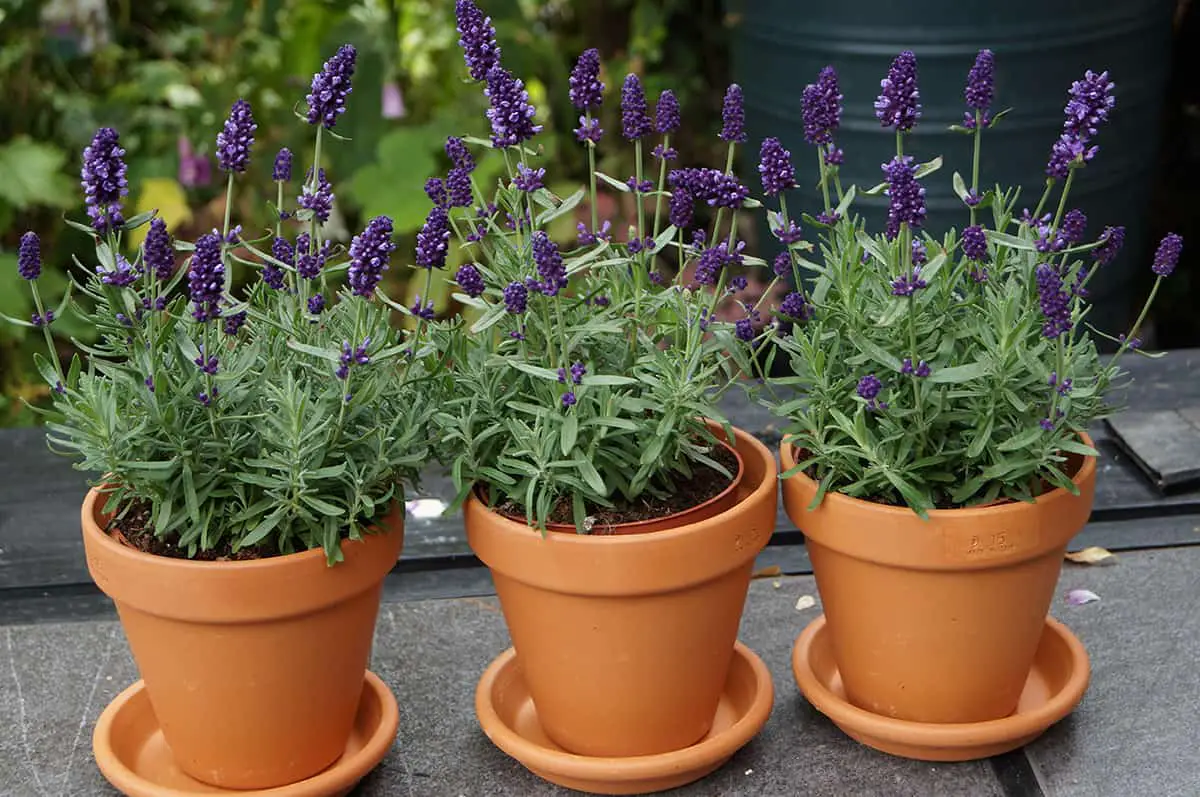
Lavandula angustifolia, commonly known as lavender, is a cherished houseplant. Its purple flowers can make your space vibrant. This plant is hardy and has a refreshing aroma. Lavender prefers sunny spots and well-drained soil.
Lavender’s gray foliage contrasts its flowers beautifully. You can find these plants in sizes that range from two to three feet. Some variants may be more compact. Remember to prune every couple of years for the best growth.
You should water your lavender sparingly. Over-watering can harm it, so let the soil dry between sessions. In winter, reduce the frequency even more. Keep these tips in mind, and your lavender should thrive indoors, adding a splash of purple to your home.
Chlorophytum Comosum ‘Bonnie’ (Purple Spider Plant)
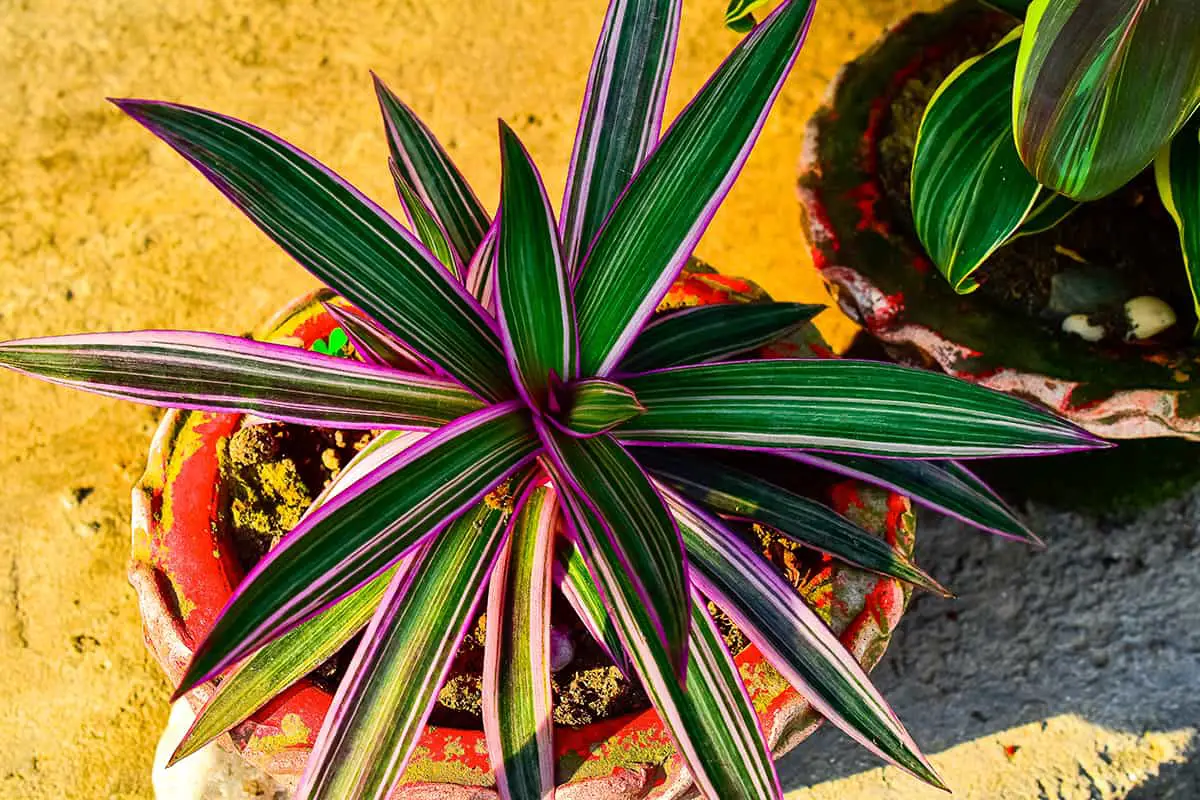
The Purple Spider Plant, known scientifically as Chlorophytum Comosum ‘Bonnie’, adds a delightful twist to the conventional spider plant with its richly curled leaves. It showcases a dynamic color palette within its foliage, featuring splashes of green and creamy white, arranged in an eye-catching rosette pattern.
Regarding light, the Purple Spider Plant flourishes best in bright, indirect light but shows resilience by adjusting well to more dimly lit areas.
For watering, it’s crucial to maintain a consistent level of moisture in the soil without letting it become waterlogged, which could cause root rot.
This plant enjoys a temperature range of 65-75°F (18-24°C), indicating its preference for warmer environments typical of indoor settings.
To promote healthy root development, it’s advisable to pot the Purple Spider Plant in a container with drainage holes using well-draining soil, which helps prevent excess water retention.
Your Purple Spider Plant might produce small white flowers on long, slender stems. The flowers are a charming bonus to its already striking foliage.
Sinningia Speciosa (Gloxinia)
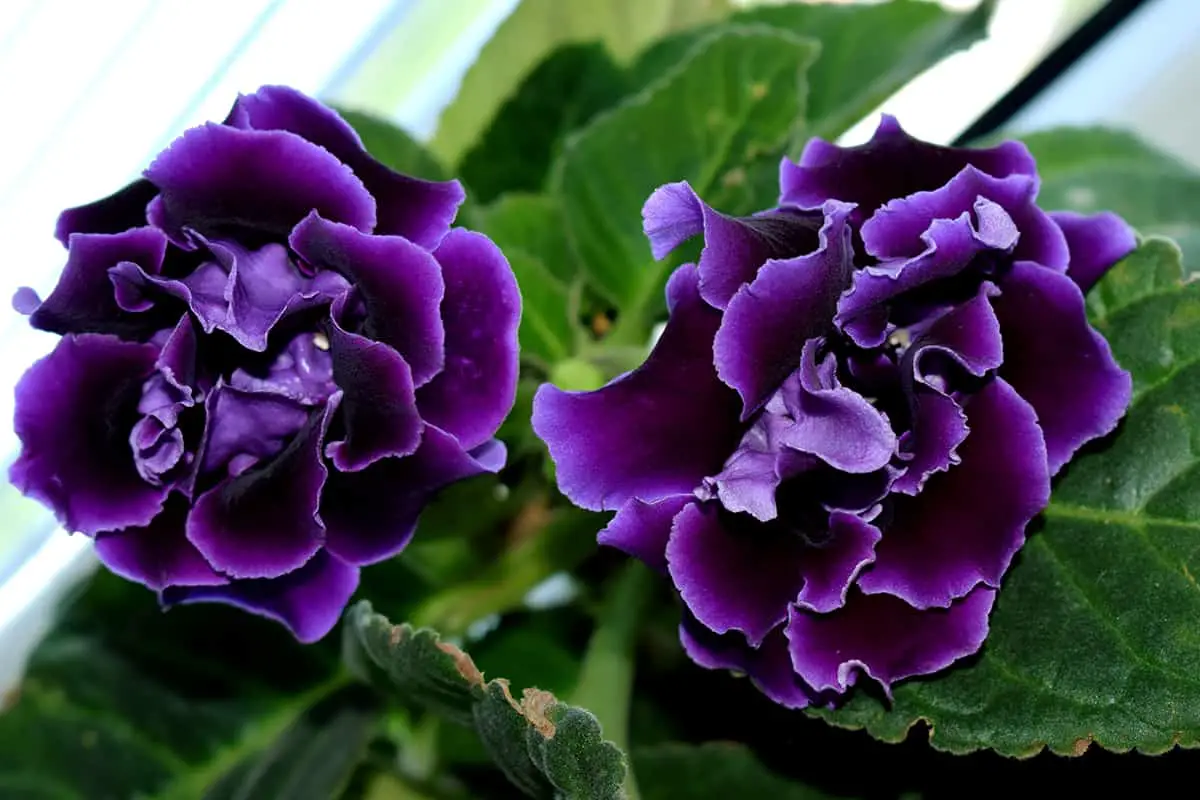
Sinningia speciosa, known as Gloxinia, is a popular houseplant. Its lush, velvety leaves and vibrant, bell-shaped flowers add a touch of elegance to your space. Gloxinia blooms in various colors, including shades of pink, red, and the sought-after purple.
Caring for your Gloxinia is straightforward and rewarding. For optimal health and vibrant flower coloration, position your Gloxinia in a spot where it will receive bright, indirect light. To prevent root rot, which is a common issue, avoid overwatering your plant. Additionally, it’s important to keep water off the foliage to prevent leaf damage.
When in bloom, the Gloxinia’s flowers can last for a few weeks. After flowering, the plant requires a period of dormancy. At this time, reduce watering and store the tuber in a cool, dark place. When new growth appears, resume regular care.
Streptocarpus Spp. (Cape Primrose)
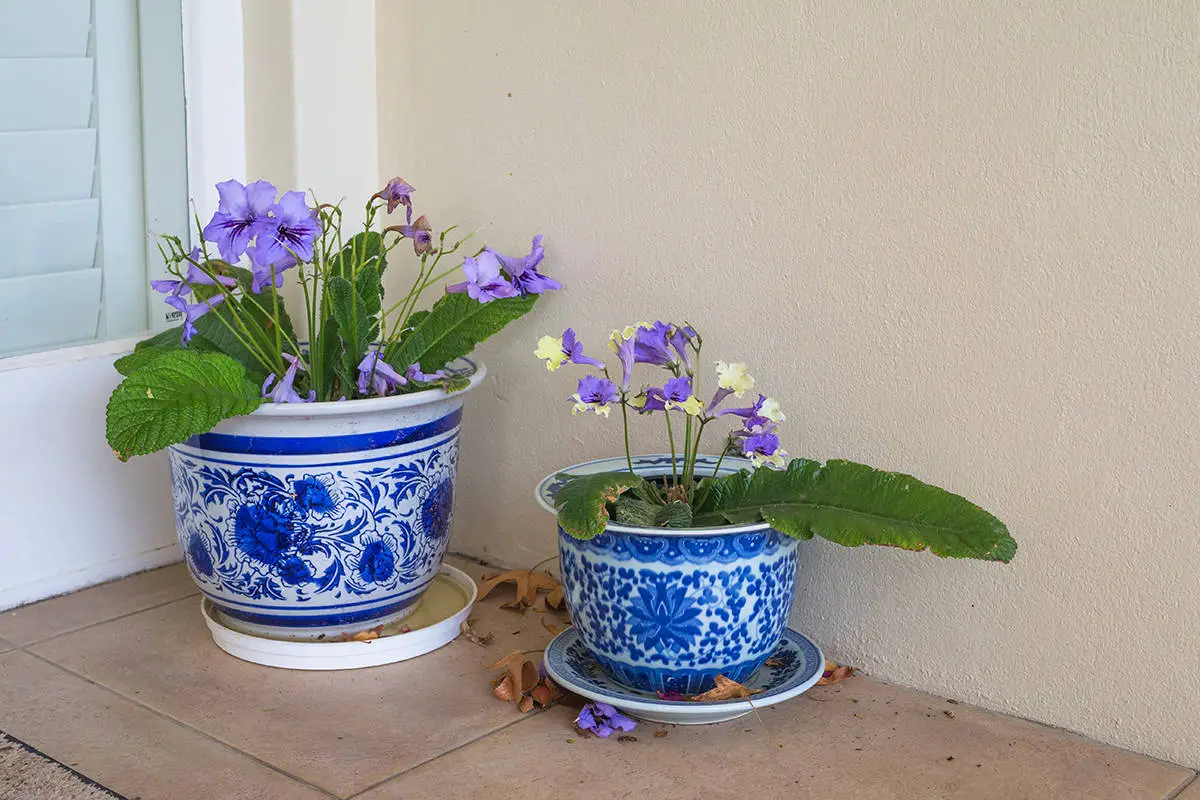
Cape Primrose, often known as Streptocarpus, adds vibrant hues to your home. These blossoms brighten indoor spaces with their purple tones. Originating from South Africa, they adapt well as houseplants. With proper care, you’ll enjoy their beauty year-round.
Your Cape Primrose requires light but not direct sunlight. Place it in bright, indirect light to maintain flower color. It’s important to keep the soil moist. Overwatering, however, can harm the plant.
The plant’s leaves are long and often wavy. They form a rosette and can create a lush look. The flowers range from white to deep purple and may have contrasting blotches.
For the best growth, use well-draining soil and a pot with drainage holes. Feed your Streptocarpus with a balanced fertilizer during the growing season. This cultivates healthy blooms and foliage. Remember to allow the soil to dry slightly between watering sessions.
Plectranthus Scutellarioides ‘Wizard Velvet Red’ (Wizard Velvet Red Coleus)
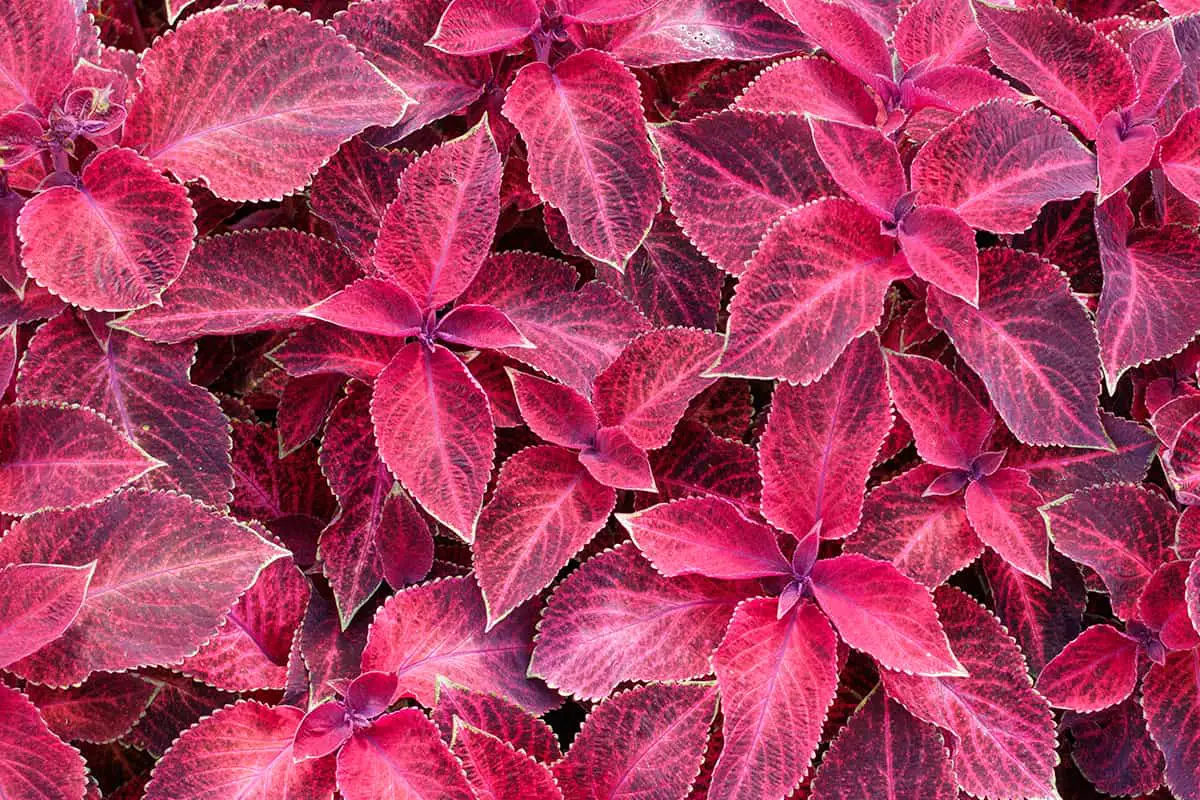
Wizard Velvet Red Coleus is a vibrant houseplant with striking foliage. It brings boldness to your indoor plant collection. You’ll find its leaves in deep red shades, edged with touches of dark green. This plant can brighten dim corners in your home.
Wizard Velvet Red Coleus thrives in well-draining soil and partial shade. You should water it when the soil feels dry. To ensure robust growth, offer it regular fertilization during the growing season.
This variety is recognized for its resilience. It adapts well to both indoor and outdoor settings. Yet, you should guard it from frost, as cold temperatures can damage it. In warmer months, it can flourish outdoors. As with many plants, you must protect it from pests.
